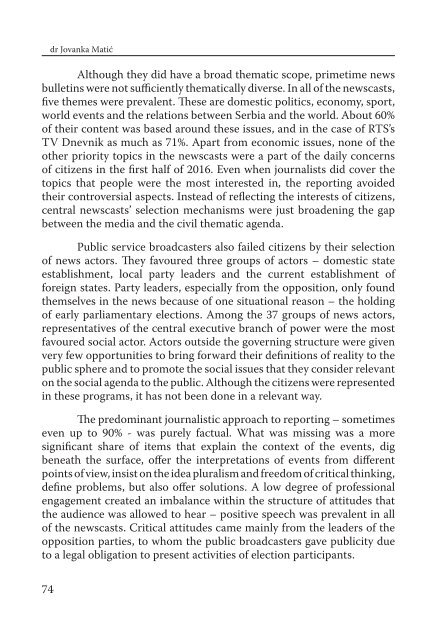Create successful ePaper yourself
Turn your PDF publications into a flip-book with our unique Google optimized e-Paper software.
dr Jovanka Matić<br />
Although they did have a broad thematic scope, primetime news<br />
bulletins were not sufficiently thematically diverse. In all of the newscasts,<br />
five themes were prevalent. These are domestic politics, economy, sport,<br />
world events and the relations between Serbia and the world. About 60%<br />
of their content was based around these issues, and in the case of RTS’s<br />
TV Dnevnik as much as 71%. Apart from economic issues, none of the<br />
other priority topics in the newscasts were a part of the daily concerns<br />
of citizens in the first half of 2016. Even when journalists did cover the<br />
topics that people were the most interested in, the reporting avoided<br />
their controversial aspects. Instead of reflecting the interests of citizens,<br />
central newscasts’ selection mechanisms were just broadening the gap<br />
between the media and the civil thematic agenda.<br />
Public service broadcasters also failed citizens by their selection<br />
of news actors. They favoured three groups of actors – domestic state<br />
establishment, local party leaders and the current establishment of<br />
foreign states. Party leaders, especially from the opposition, only found<br />
themselves in the news because of one situational reason – the holding<br />
of early parliamentary elections. Among the 37 groups of news actors,<br />
representatives of the central executive branch of power were the most<br />
favoured social actor. Actors outside the governing structure were given<br />
very few opportunities to bring forward their definitions of reality to the<br />
public sphere and to promote the social issues that they consider relevant<br />
on the social agenda to the public. Although the citizens were represented<br />
in these programs, it has not been done in a relevant way.<br />
NEWS AND INFORMATION PROGRAMMING OF THE SERBIAN NATIONAL AND<br />
VOJVODINA REGIONAL PUBLIC SERVICE BROADCASTERS (RTS AND RTV)<br />
By ignoring the many controversies of social life, giving primacy<br />
to the public interest definitions formulated by the state establishment,<br />
choosing speakers in the programmes who do not express critical<br />
attitudes, central news bulletins of both national and regional public<br />
broadcasters did not help neither in free formation nor expression of the<br />
opinions of its audience, as their purposes are outlined by the Law on<br />
Public Service Broadcasting.<br />
The selection matrix of editorial policy was not neutral towards<br />
different interests in society, and different ideas, as is required by the<br />
aforementioned Act for both RTS and RTV. It better served the interests<br />
of the power holders than of other social actors. This is clearly evident<br />
in the treatment of the central top executive authorities and the new<br />
provincial government after the elections in Vojvodina, both of which<br />
were very privileged in the amount and type of publicity they received.<br />
If one can use the metaphor of a mirror when speaking about<br />
central news bulletins of the national and regional public service<br />
broadcasters, than one should remember Aldous Huxley’s insight –a<br />
mirror always provides a reflection of its holder. The pictures of reality<br />
created by these programs reflect the editorial policies of RTS and RTV,<br />
and not the reality in which their audiences live in.<br />
The predominant journalistic approach to reporting – sometimes<br />
even up to 90% - was purely factual. What was missing was a more<br />
significant share of items that explain the context of the events, dig<br />
beneath the surface, offer the interpretations of events from different<br />
points of view, insist on the idea pluralism and freedom of critical thinking,<br />
define problems, but also offer solutions. A low degree of professional<br />
engagement created an imbalance within the structure of attitudes that<br />
the audience was allowed to hear – positive speech was prevalent in all<br />
of the newscasts. Critical attitudes came mainly from the leaders of the<br />
opposition parties, to whom the public broadcasters gave publicity due<br />
to a legal obligation to present activities of election participants.<br />
74 75


